
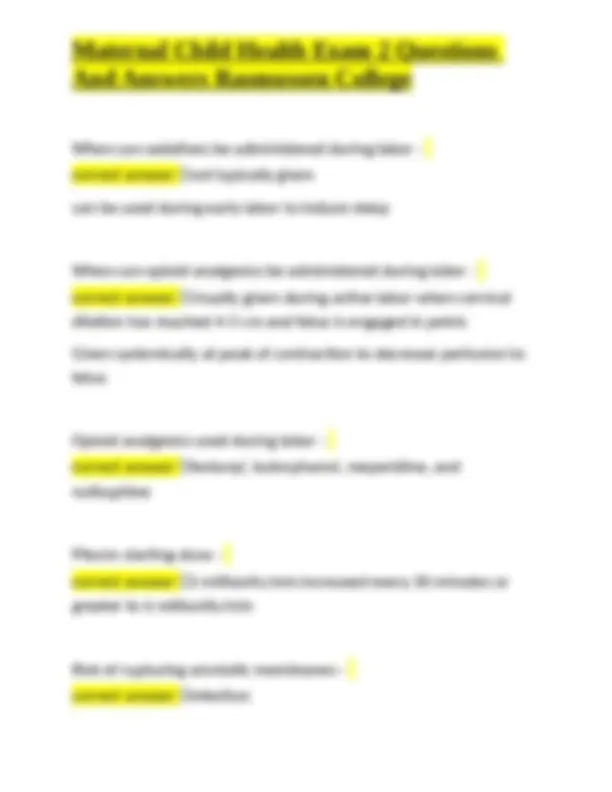
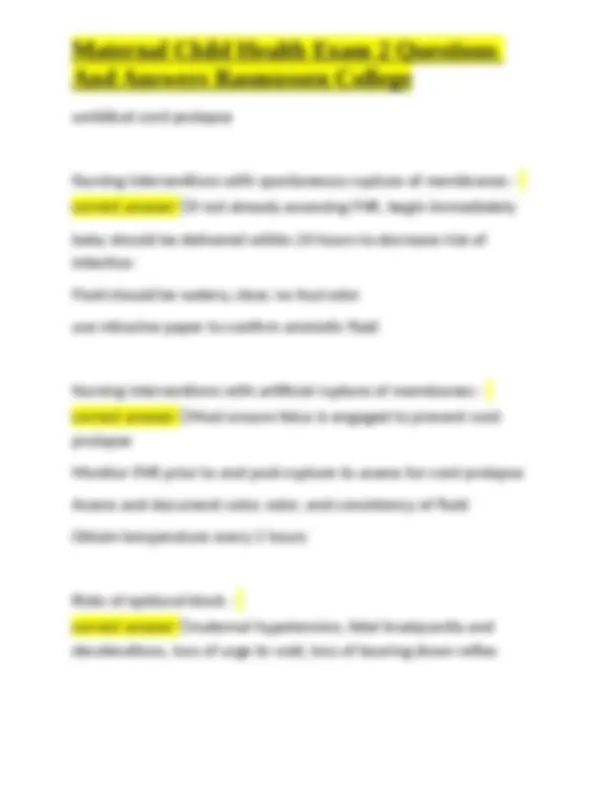
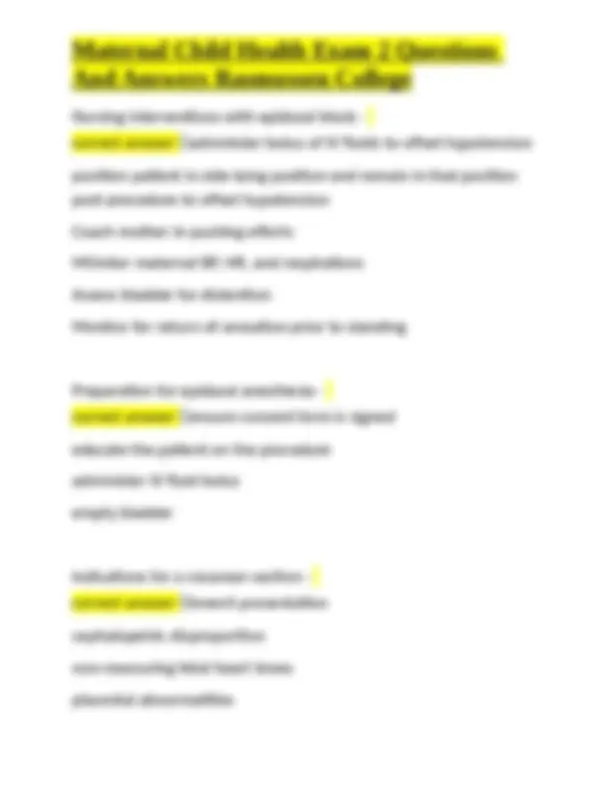
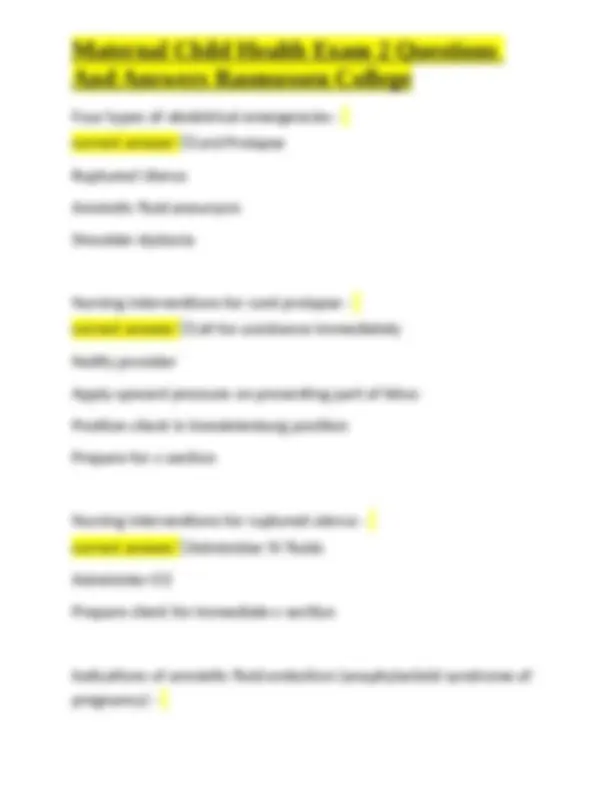
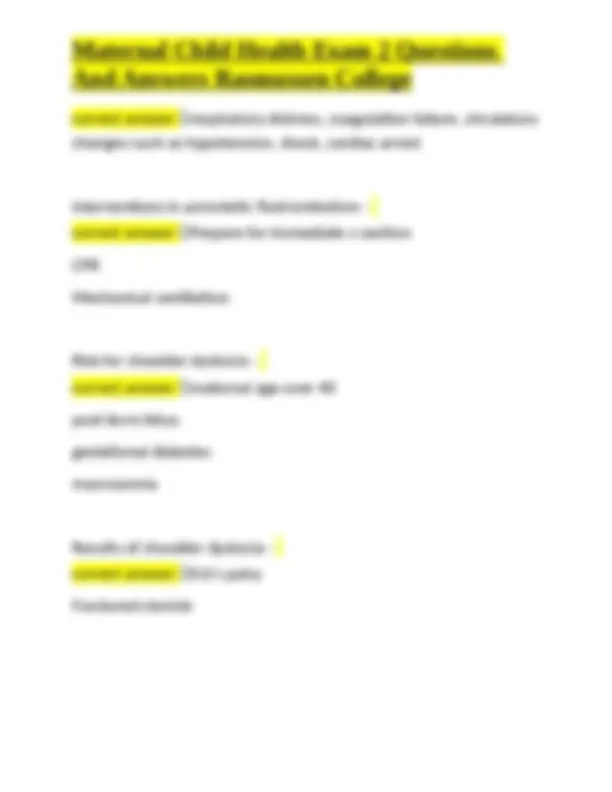
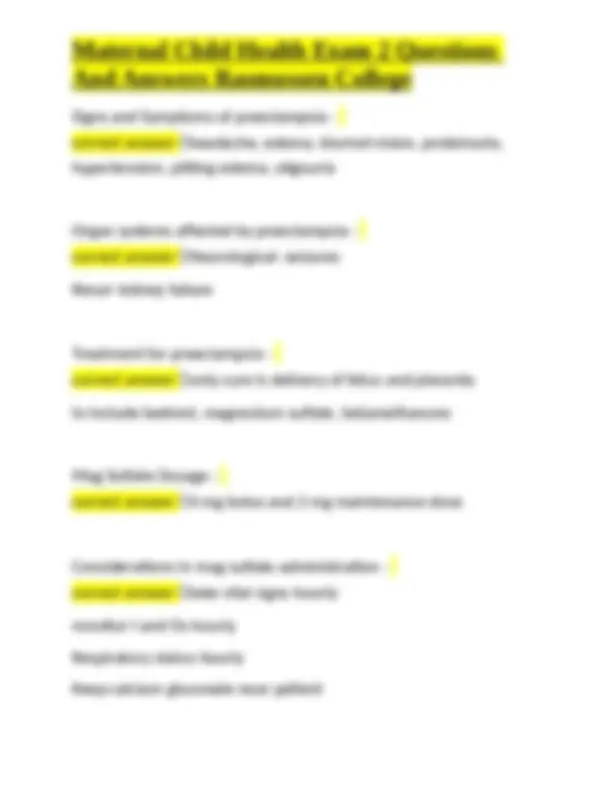
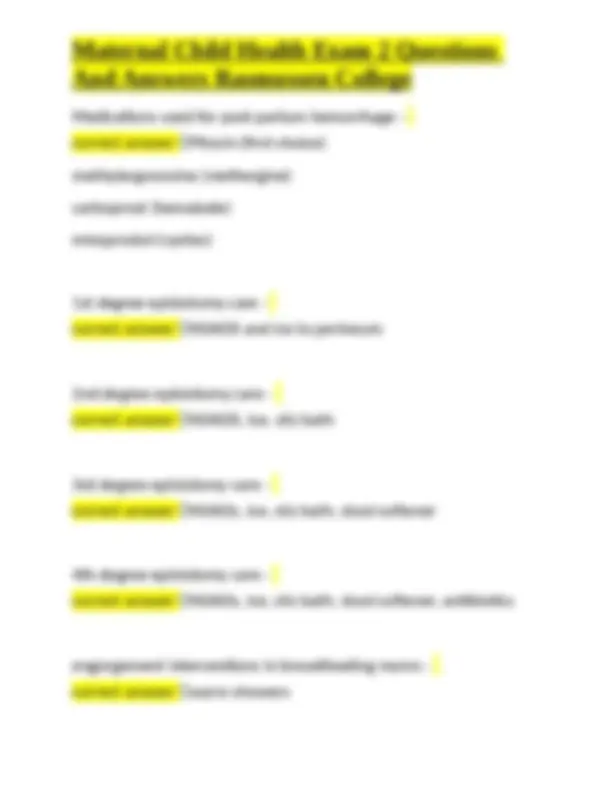
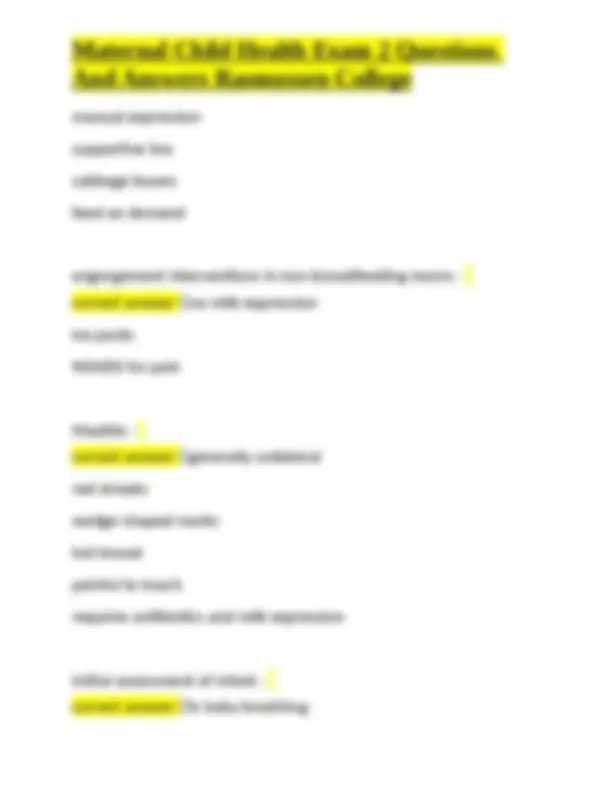
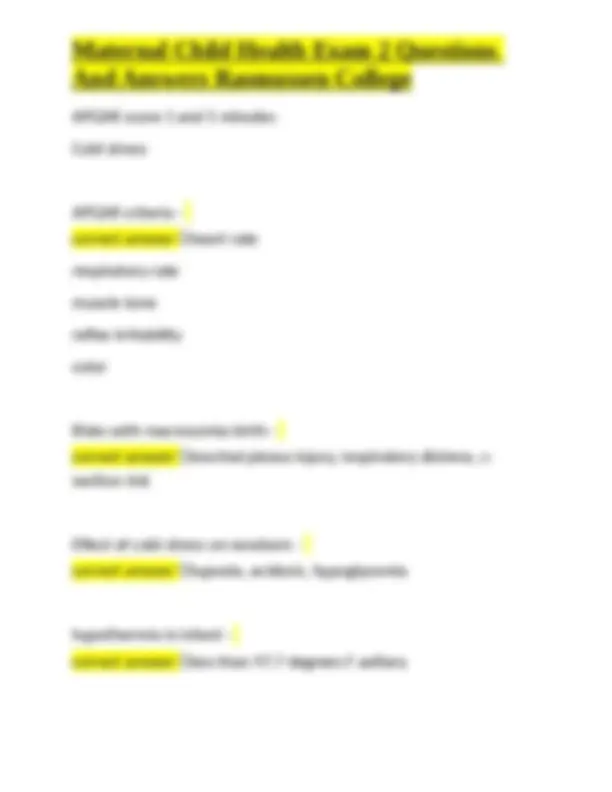
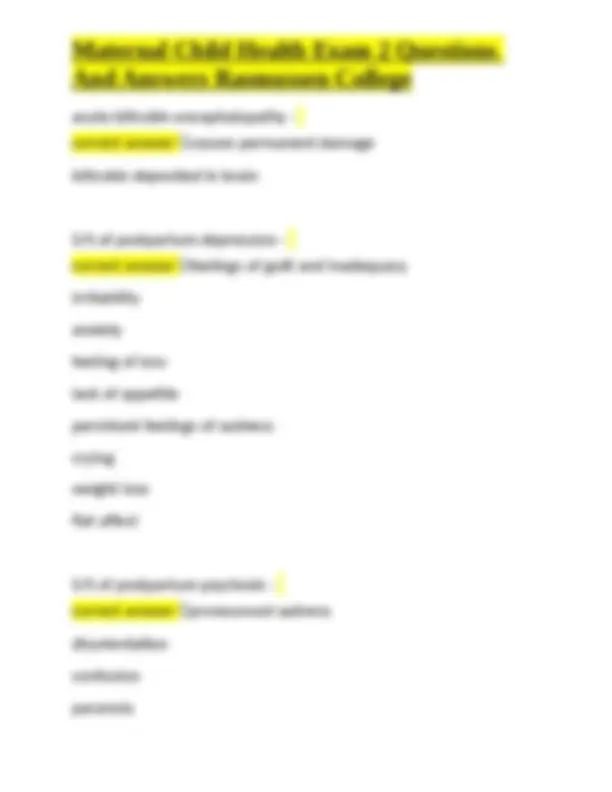



Study with the several resources on Docsity

Earn points by helping other students or get them with a premium plan


Prepare for your exams
Study with the several resources on Docsity

Earn points to download
Earn points by helping other students or get them with a premium plan
Community
Ask the community for help and clear up your study doubts
Discover the best universities in your country according to Docsity users
Free resources
Download our free guides on studying techniques, anxiety management strategies, and thesis advice from Docsity tutors
Maternal Child Health Exam 2 Questions And Answers Rasmussen College
Typology: Exams
1 / 19

This page cannot be seen from the preview
Don't miss anything!












First phase of stage one of labor - correct answer ✅Latent phase. Cervical dilation is 0-3 cm, contractions are mild to moderate, every 5 to 30 minutes for 30- seconds. Mother is talkative and eager Second phase of stage one of labor - correct answer ✅active phase, cervical dilation is 4-7 cm, contractions are moderate to strong every 3-5 minutes lasting 40- 70 seconds, cervical dilation and effacement is rapid, mother feels helpless, restless, and anxious Third phase of stage one of labor - correct answer ✅-Transitional phase, cervical dilation cm, station 0 or -1, contractions strong to very strong every 2-3 minutes for 45- 90 seconds, mother feels tired, out of control, rectal pressure, urge to push, irratible Stage two of labor - correct answer ✅from complete dilation to delivery of the baby, intense contractions every 2 to 3 minutes
Stage three of labor - correct answer ✅from the birth of HBG and HCTthe infant to the delivery of the placenta, approx 5-30 minutes time Stage four of labor - correct answer ✅from the delivery of placenta to the return of vital sign homeostasis, approx 2-4 hours, lochia is scant to moderate Important labs in labor - correct answer ✅platelets within normal range (150,000-450,000) HBG and HCT UA for infections and drugs Rh type Group B Strep status Reasons and findings of vaginal exams in labor - correct answer ✅Determine cervical dilation and effacement measure station of fetus in birth canal fetal position, presenting part and lie Are membranes intact or ruptured
umbilical cord prolapse Nursing interventions with spontaneous rupture of membranes - correct answer ✅if not already assessing FHR, begin immediately baby should be delivered within 24 hours to decrease risk of infection Fluid should be watery, clear, no foul odor use nitrazine paper to confirm amniotic fluid Nursing interventions with artificial rupture of membranes - correct answer ✅Must ensure fetus is engaged to prevent cord prolapse Monitor FHR prior to and post-rupture to assess for cord prolapse Assess and document color, odor, and consistency of fluid Obtain temperature every 2 hours Risks of epidural block - correct answer ✅maternal hypotension, fetal bradycardia and decelerations, loss of urge to void, loss of bearing down reflex
Nursing interventions with epidural block - correct answer ✅administer bolus of IV fluids to offset hypotension position patient in side-lying position and remain in that position post-procedure to offset hypotension Coach mother in pushing efforts MOnitor maternal BP, HR, and respirations Assess bladder for distention Monitor for return of sensation prior to standing Preparation for epidural anesthesia - correct answer ✅ensure consent form is signed educate the patient on the procedure administer IV fluid bolus empty bladder Indications for a cesarean section - correct answer ✅breech presentation cephalopelvic disproportion non-reassuring fetal heart tones placental abnormalities
Assess for indications of DVT Monitor I and Os via foley Monitor vital signs Encourage coughing, deep breathing, splinting, and turning Encourage ambulation Assess LOC, lungs, heart, and bowel sounds Assess for sensation in extremities VBAC Criteria - correct answer ✅No uterine scars or ruptures with exception of low transverse incisions Clinically adequate pelvis provider and anesthesia immediately available during active labor No contraindications such as LGA fetus, malpresentation Non-Pharmacological pain management during labor - correct answer ✅lamaze, patterned breathing, hypnosis, biofeedback, aromatherapy, imagery, music, focal points, massage, effleurage
Four types of obstetrical emergencies - correct answer ✅Cord Prolapse Ruptured Uterus Amniotic fluid aneurysm Shoulder dystocia Nursing interventions for cord prolapse - correct answer ✅Call for assistance immediately Notify provider Apply upward pressure on presenting part of fetus Position client in trendelenburg position Prepare for c-section Nursing interventions for ruptured uterus - correct answer ✅Administer IV fluids Administer O Prepare client for immediate c-section Indications of amniotic fluid embolism (anaphylactoid syndrome of pregnancy) -
Signs and Symptoms of preeclampsia - correct answer ✅headache, edema, blurred vision, proteinuria, hypertension, pitting edema, oligouria Organ systems affected by preeclampsia - correct answer ✅Neurological- seizures Renal- kidney failure Treatment for preeclampsia - correct answer ✅only cure is delivery of fetus and placenta tx include bedrest, magnesium sulfate, betamethasone Mag Sulfate Dosage - correct answer ✅4 mg bolus and 2 mg maintenance dose Considerations in mag sulfate administration - correct answer ✅take vital signs hourly monitor I and Os hourly Respiratory status hourly Keep calcium gluconate near patient
Acceptable baseline FHR - correct answer ✅110-160 bpm Absent baseline variability - correct answer ✅considered non-reassuring Minimal baseline variability - correct answer ✅need to observe, could be due to fetal sleep cycle Moderate variability - correct answer ✅considered normal and expected Accelerations of FHR - correct answer ✅reassuring heart tones Late deceleration cause - correct answer ✅placental or uterine insufficiency
Medications used for post-partum hemorrhage - correct answer ✅PItocin (first choice) methylergonovine (methergine) carboprost (hemabate) misoprostol (cyotec) 1st degree episiotomy care - correct answer ✅NSAIDS and ice to perineum 2nd degree episiotomy care - correct answer ✅NSAIDS, ice, sitz bath 3rd degree episiotomy care - correct answer ✅NSAIDs, ice, sitz bath, stool softener 4th degree episiotomy care - correct answer ✅NSAIDs, ice, sitz bath, stool softener, antibiotics engorgement interventions in breastfeeding moms - correct answer ✅warm showers
manual expression supportive bra cabbage leaves feed on demand engorgement interventions in non-breastfeeding moms - correct answer ✅no milk expression ice packs NSAIDS for pain Mastitis - correct answer ✅generally unilateral red streaks wedge-shaped marks hot breast painful to touch requires antibiotics and milk expression Initial assessment of infant - correct answer ✅Is baby breathing
Benefits of breastfeeding - correct answer ✅baby receives antibidies promotes brain growth easy to digest reduces risk of SIDS decreased postpartum bleeding faster involution bonding ease cost Types of circumcision techniues - correct answer ✅mogen clamp gomco clamp plastibell technique S/S of neonatal pain - correct answer ✅prolonged intense crying withdrawing neonatal infant pain scales
management of neonatal pain - correct answer ✅nonnutritive sucking kangaroo care swaddling Expected findings in neonatal abstinence syndrome - correct answer ✅high-pitch cry, incessant screaming, tremors, increased moro reflex, disturbed sleep patterns, poor feeding, vomiting Physiological jaundice - correct answer ✅considered benign appears 72 to 120 hours after birth encourage feeding to eliminate bilirubin Pathologic jaundice - correct answer ✅is the result of disease process appears before 24 hours of age
hallucinations thoughts of harming self/infant